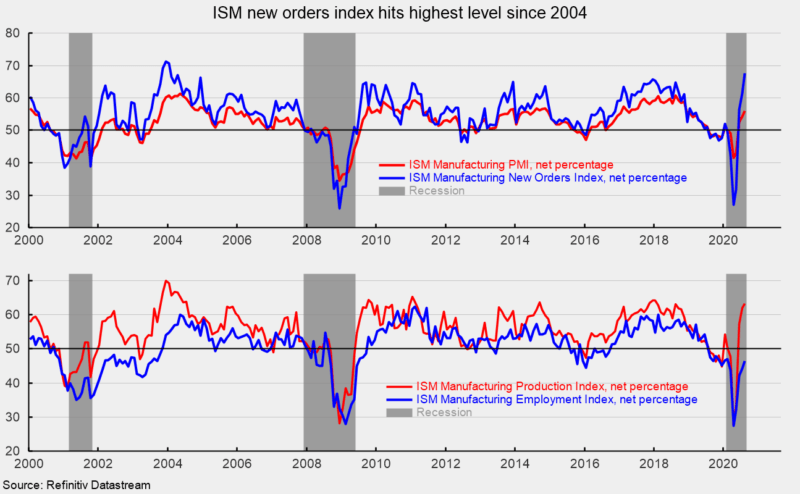Manufacturing Sector Recovery Continued in August
The Institute for Supply Management’s Manufacturing Purchasing Managers’ Index rose again in August, posting a 56.0 percent reading for the month, up from 54.2 percent in July. The latest result is the third consecutive reading above the neutral 50 threshold and fourth consecutive month of improvement since hitting a low of 41.5 in April (see top chart). Overall, the report notes, “The PMI signaled a continued rebuilding of economic activity in August and reached its highest level of expansion since November 2018, when the index registered 58.8 percent.”
Among the key components, the New Orders Index came in at 67.6 percent, up from 61.5 percent in July, and the highest result since January 2004 (see top chart). Fifteen of eighteen industries in the survey reported growth in new orders in August. The New Export Orders Index came in at 53.3 percent in August, up 2.9 percentage points from a 50.4 percent result in July. The Backlog-of-Orders Index came in at 54.6 percent in August, up from 51.8 percent in the prior month.
The Production Index registered a 63.3 percent result in August, up from 62.1 percent in July and the highest reading since January 2018 (see bottom chart). Fifteen industries reported growth in the latest month, including: wood products; primary metals; chemical products; plastics and rubber products; nonmetallic mineral products; transportation equipment; textile mills; machinery; food, beverage and tobacco products; fabricated metal products; petroleum and coal products; electrical equipment, appliances and components; miscellaneous manufacturing; computer and electronic products; and paper products.
The Employment Index posted another modest gain, rising 2.1 percentage points to 46.4 percent in August, versus 44.3 percent in July (see bottom chart). However, the employment index remained below neutral for a 13th consecutive month suggesting labor dynamics in the manufacturing sector remain weak. The Bureau of Labor Statistics’ Employment Situation report for August is due out on Friday, September 4th. Despite the continued weak readings from the ISM survey, consensus expectations are for a gain of 1.4 million nonfarm-payroll jobs including the addition of 50,000 jobs in manufacturing. The unemployment rate is expected to fall to 9.8 percent from 10.2 percent in July.
The Supplier Deliveries Index, a measure of delivery times from suppliers to manufacturers, rose to 58.2 percent from 55.8 percent in July. Slower supplier deliveries are usually consistent with stronger manufacturing activity. However, the slower deliveries in recent months have been more a result of supply chain and logistical constraints. According to the report, “The Supplier Deliveries Index now better reflects supplier’s difficulty in maintaining delivery rates due to factory labor safety issues and transportation difficulties.”
The Prices Index rose to 59.5 percent in August from 53.2 percent in July and the highest level since 2018. Seventeen industries paid higher prices for raw materials in August. Higher prices were reported for: aluminum, copper, crude oil, freight, high-density polyethylene, lumber, natural gas, packaging materials, polyethylene, polypropylene, precious metals, propylene, steel, steel scrap, and stainless steel.
Customer inventories in August are still considered too low, with the index remaining below 50 at 38.1 percent versus 41.6 percent in the prior month (index results below 50 indicate customers’ inventories are too low). The index has been below 50 for 47 consecutive months. Insufficient inventory may be a positive sign for future production.






